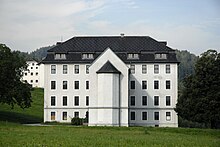Hauzenheim residence
The Hauzenheim residence (sometimes also referred to as the Stachelburg ) is located in the municipality of Volders in the Innsbruck-Land district of Tyrol (Volderwaldstrasse 6). In the 20th century, this was the home of the Kleinvolderberg youth home, which was closed in 1990.
History of the residence
Hauzenheim was a Kunkellehen the County of Tyrol. The noble von Vögler held it until 1495, named Gottselin (1278) and Conrad von Vögler (1317). The edl vnd vest Kristoff Vegler von Hauczenhaim is documented as late as 1451 . After that, the nobles von Dieperskircher and Liechtenstein (1497), the Waltenhofer (1502), the Händl and Bärenecker are named here. In 1509 Hans von Dieperskircher sold his share of the property to Sigmund Bärenecker and in 1511 Thomas von Liechtenstein to Georg Fuchs von Fuchsberg.
In 1603 the property came to Ernst von Stachelburg, which is why the residence was popularly called Stachelburg from then on. Simon Felix Freiherr von Crosina, imperial treasurer and Upper Austrian court chamber councilor married Anna Katharina, the only daughter of Johann Philipp's Count von Stachelburg and Freiherr von Hauzenheim. As a result, he came to the Stachelburg noble seat Hauzenheim and other possessions. When his first wife died in 1741, he married Theresia Countess von Spaur. She also died before him and so he married for the third time in 1766, namely Viktoria Eleonora Countess of Prato. His children had already died before him, so he donated his fortune to the male orphanage in Trient († November 30, 1776), with his widow enjoying the fruit from his possessions until her death († October 2, 1811). Other owners were the Counts of Wicka and the de Romedis family of Fondo; They had the residence allodized in 1833 and then it was sold to a farmer .
In 1889 the residence was acquired by the Catholic Association of Children's Friends in Salzburg and adapted for the Josefinum asylum founded in 1886 for “orphaned and neglected boys”. After the construction of an extension, the institution was able to be put into operation in 1890. In addition, a primary school was set up and, from the beginning of the 20th century, a grammar school, which was converted into a secondary school in the interwar period.
The Josefinum was expropriated by the National Socialists in 1939 and a Gau educational home for school-age girls was set up here.
Hauzenheim residence today
As early as 1945 it was reopened as the Kleinvolderberg state educational center for male youths. The young people were employed in the home workshops (gardening, locksmithing, carpentry, tailoring, shoemaking and bakery) as well as in agriculture. The number of young people accommodated fell continuously from 120 in the 1960s to 43 young people in 1973. From 1975 onwards, there was a reorientation, whereby the professional integration was increased. Around half of the young people were accommodated in “outdoor workplaces”. In 1990 the Kleinvolderberg home was closed.
Massive allegations of physical abuse of the children and adolescents by the educators were also made against Heim Kleinvolderberg ; an example of this is the article “We called it Kleinfolterberg”. There is talk of beating attacks with pounding rods made of cable covers and knots, of “balding scissors”, of standing under an ice-cold shower and being locked up in the in-house cell for days.
literature
- Johann Jakob Staffler : Tyrol and Vorarlberg: in 2 parts. Innsbruck: Felician Rauch, 1839.
Individual evidence
- ^ Hannes Obermair : Bozen Süd - Bolzano Nord. Written form and documentary tradition of the city of Bozen up to 1500 . tape 2 . City of Bozen, Bozen 2008, ISBN 978-88-901870-1-8 , p. 108-109, No. 1045 .
- ^ The extinct noble families of Tyrol. Second alphabetical order. With a coat of arms.
- ↑ Johann Jakob Staffler , 1839, p. 619.
- ↑ Contact point for victim protection of the state of Tyrol: final report 2010/2011
- ↑ Heidi Rinke-Jarosch: "We called it Kleinfolterberg"
Web links
- Entry for the Hauzenheim residence in the private database “Alle Burgen”.
- Homes in Tyrol and Vorarlberg
- Steering group "Victim Protection Tyrol" , report to the Tyrolean provincial government (2010)
Coordinates: 47 ° 16 ′ 41.9 ″ N , 11 ° 32 ′ 58 ″ E

